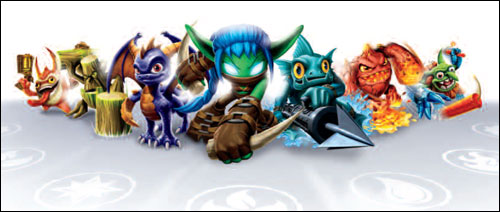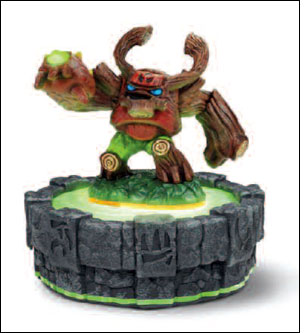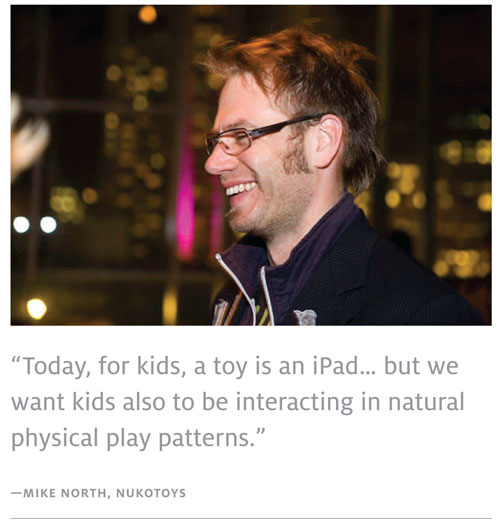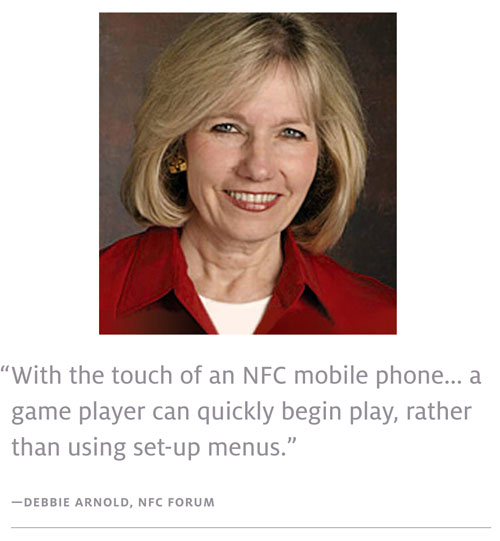Oct 01, 2012"Skylanders is my favorite video game," says my 9-year-old son, as he positions his Legendary Bash action figure atop the Portal of Power accessory and watches the figure come to life onscreen in his Wii gaming system. "It's cool," he says, though he's not referring to the Near-Field Communications (NFC) reader in the Portal of Power that reads the NFC tag in the action figure. "It's easy to switch characters during the game, and I can play at my friends' houses with my action figures and their system knows it's my guys."
He's not the only one enthralled with Skylanders: Spyro's Adventure, released last fall by Activision Blizzard. The game is available for Nintendo, PlayStation and Xbox gaming consoles, as well as PC and Mac computers, in addition to the Wii. While reporting its second-quarter earnings, in August, Activision Blizzard said the game was one of the top three titles so far this year in North America and Europe, and Skylanders toys were the top-selling action figures in the United States in the first half of 2012.
NFC—a short-range wireless technology that enables device-to-device data transfers—is ushering in a new age of gaming, opening up a world in which kids of all ages can bridge the divide between physical and virtual play. In addition to NFC gaming systems, NFC mobile phones allow gamers to interact with each other and with real-world objects. And some organizations are inviting players to use NFC mobile devices to search for clues in their environment to win a game or contest.
NFC technology is not designed to handle large amounts of information, but the quantity of data that must be transferred in Skylanders is not significant. That means several tagged action figures can interact when simultaneously placed on the Portal of Power.
Activision Blizzard clearly has capitalized on the fact that there's gold in those action figures. A Skylanders Starter Pack with the Portal of Power costs approximately $60, but I know from personal experience that kids will want the additional characters and Expansion Packs needed to gain access to new adventure levels. "Now vendors are not just selling video game discs, but they are selling characters that probably cost relatively little to produce," says John Shuster, a VDC Research analyst. "And if you are a heavy gamer, you probably will spend whatever it costs to buy multiple characters, especially to facilitate progress in the game. But there are benefits on both sides of the fence, because it is a more fun and interactive experience for those playing the game."
"It's cool to say it's there in products like the Wii U," Shuster says. "But there have got to be apps to make use of it. We are still in the very early days."
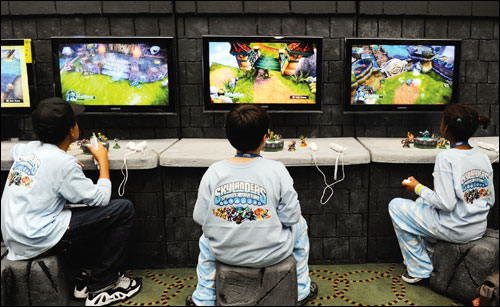
We are just seeing the beginning of a promising trend, says Jeff Miles, VP of mobile transactions at NXP Semiconductors, which makes the NFC technology used in one of today's most popular gaming products. "Different game makers will start to create different ways of using physical objects in games. Think of reality games where you could bring an object from a store [with an NFC tag in it] and suddenly it's a device that someone has in the game."
Blending the physical world of toys with the virtual world of games is where Nukotoys is heading. "Today, for kids, a toy is an iPad. That is the number 1 requested toy," says Mike North, Nukotoys CTO. "But we want kids also to be interacting in natural physical play patterns." The company's games, Animal Planet Wildlands and Monsterology, are played on the iPad, but kids collect trading cards that, in Wildlands, for example, can be tapped on the screen to search for hidden items, run races and trigger educational videos.
Since the iPad doesn't support NFC yet, North says, the games rely on Printechnologics' Touchcode technology, an invisible electronic code printed on media that can be put on a tablet display to read data. But Nukotoys has experience developing games with RFID technology. The company designed an educational game for schools, called Mission to Planet 429, as part of a PBS Kids project. RFID readers were installed in custom cases of iPods given to children, to read the game's trading cards and serve as an interface to the computer application.
While NFC gaming is still in the early stages, it's getting a boost from the growing number of NFC-enabled phones and tablets. Google has been a public supporter of NFC with its Android platform, and Microsoft has integrated the technology into Windows 8 and Windows Phone 8. Barnes & Noble plans to incorporate NFC into its Nook e-reader, and the bookseller recently created a partnership with Microsoft, forming a subsidiary that will include its Nook business. Forrester Research predicts some 100 million NFC-enabled mobile devices will ship globally this year.
The Nokia Research Center has made available a series of games users can play on Nokia Symbian NFC-enabled smartphones. To play, you need NFC tags—those you buy separately or those in transit cards, ID badges or hotel key cards. Then, you just tap or wave the phone over the tags or cards to play, for example, a world flags matching game or one in which you try to complete quotes from Shakespeare. "The research I'm doing here at Nokia is basically creating new ways to use NFC, not just for payments but actually as a tangible user interface," explains Luis F.G. Sarmenta, a principal scientist at Nokia Research Center, in a video on the Nokia Beta Labs NFC Games site. "This will enable basically a new class of games limited only by the creativity of the developer."
Nokia took NFC gaming outside the lab, when it announced last year that all Nokia NFC-enabled devices would come preinstalled with Rovio Mobile's Angry Birds Magic as an exclusive. In a peer-to-peer implementation of NFC technology, tapping two NFC phones together unlocks new levels in the game. Players also can wave their devices in front of NFC tags in official merchandise or designated locations, such as Angry Birds Activity Parks, to unlock levels or earn rewards. Similarly, players on NFC-enabled smartphones running the Symbian Belle operating system can download the NFC version of Halfbrick Studios' Fruit Ninja, to unlock contents by handshaking with another Nokia NFC smartphone. Nokia now is transitioning its models to the Windows Phone operating system.
Handshaking goes to an altogether different level with a game called TapThat, described on the TapThat Web site as "Google Wallet, But With Sex." The game was a finalist in Tap Into Innovation: NFC Global Competition 2012, sponsored by the NFC Forum and WIMA, and a winner of global communications agency Isobar's Create 32 NFC Hackathon. TapThat invites players to assume an identity, such as Homer Simpson or Lady GaGa, and then "get physical" by tapping their NFC phones together.
NFC has some advantages over Bluetooth, the predominant way of bringing people together to play games on mobile devices, says Andrew Song, CEO of TapThat. Bluetooth involves hassles, he says, because users have to go to their Bluetooth menu, switch it on, choose the "make discoverable" option, type in a password and wait for it to pair. "With NFC, the barrier to entry to join a game is a lot less," he says. "It's gotten easier. Just tap your phones and they talk."
That said, Bluetooth or Wi-Fi technologies could be used in conjunction with NFC mobile games, according to Song. TapThat is all NFC, since it's just passing a couple of packets between users, he explains, but on its own NFC "can't transfer enough data to make a rich gaming experience" with, say, music or video.
"NFC can enhance the user experience of applications that use Bluetooth technology by making it virtually effortless to select and securely connect to a Bluetooth device and start an application on it," says Debbie Arnold, NFC Forum's director. "For example, with the touch of an NFC mobile phone to a Bluetooth gaming headset, a game player can quickly begin play, rather than using set-up menus."
In 2009, visitors to the Lappeenranta Sandcastle, a walk-through sand sculpture in Finland, were able to play an interactive game, created by NFC provider Red Solution. They borrowed an NFC phone, then touched it to a series of smart posters installed nearby to answer questions about the Sandcastle and win prizes.
Last year, at the Sundance Film Festival, in Park City, Utah, people using NFC-enabled Nexus S phones had 120 hours to stop a fictional viral outbreak, by tapping their phones to unlock clues in NFC-tagged objects placed around the city. Vectorform created Pandemic 1.0 as part of Lance Weiler's Pandemic 41.410806, -75.654259 transmedia experience, which incorporated film, social gaming and data visualization. "There was no typing in codes," says Kevin Foreman, director of product vision for Vectorform, a multiplatform interactive design company. "It was a seamless experience, and an interesting and innovative way to tell the story."
The designers created a mock Centers for Disease Control room, where players could see which virus had been unlocked and how it was spreading across Park City. By putting their phones on a Microsoft Surface table-size, multitouch computer, they could see all the pictures that people playing the game had taken during their hunts. "It was a cool way of integrating the digital and physical world into one overall experience," Foreman says. "When Lance came to us, one thing he asked was that there be seamless integration between phones and objects, and with our partnership with Google at the time, we knew the Nexus was coming as the first Android phone to support NFC. Google saw this as a big splash opportunity and gave us the devices and all the tags."
Although players didn't earn points, badges or rewards, Pandemic provided an element of "gamification," in which games or contests featuring NFC mobile devices are spearheaded by companies that want to promote a product or engage an audience. "NFC is going to have a major play in gamification, as well as gaming," says Theresa Billy, president and founder of NFC consultancy Near Field Connects. "You will see people motivated and being driven to activities through gamification. And NFC is going to let you take gamified activities and make experiences better."
Foreman expects the awareness and exposure brands can gain from integrating NFC into an experience of some sort to be a compelling reason for them to explore the technology's potential. "A positive brand experience will get tied with your brand," he says.
Apple had been expected to integrate NFC into its iPhone 5, but those rumors didn't pan out. That's not to say Apple doesn't have interest in NFC. The vendor reportedly has filed a patent application for an iPhone-NFC controls system, in which the mobile device could control a video game system, among other connected home scenarios.
"The idea of an ecosystem clearly is the aim," says NXP Semiconductors' Miles. "The ability to connect different devices or network systems—probably one of the key functions of NFC, and key directions of key operating system players—is really tying those things together as credential pairing: connecting TV set-top boxes, laptops, peripherals, accessories, the whole gamut of devices."
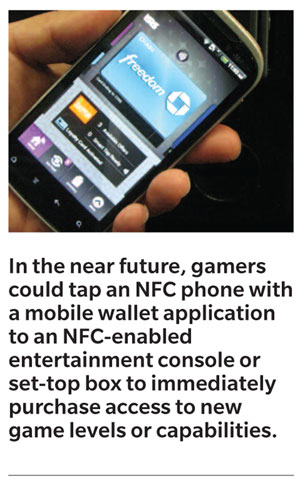
obile wallets—such as the NFC-enabled Isis Mobile Wallet, Microsoft Wallet or Google Wallet—also could come into play. Imagine, for instance, tapping an NFC phone with a mobile wallet application to an NFC-enabled entertainment console or set-top box to immediately purchase access to new game levels or capabilities. "Laws allowing, you can even imagine casino gambling in a hotel room," says NFC Forum's Arnold. "You can envision going up to the hotel TV, touching it with your phone and making a payment" to purchase, for example, a few rolls of the on-screen dice. But, she acknowledges, "once you start getting into payments, that is a whole different level of complexity."
The future may be closer than we think. Nintendo's NFC-enabled Wii U controller could support possibilities including "using it as a means of making micropayments," Iwata said during the company's third-quarter financial briefing. That means gamers might be able to buy new apps and other in-game content without having to share credit-card information over the network. I know one 9-year-old gamer who'd probably love that idea, but I don't think I'll share it with him just yet.

